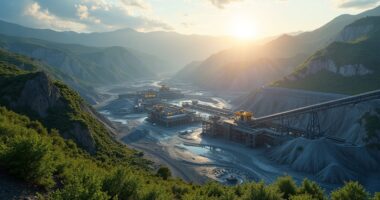The mining industry is gearing up for a major facelift by 2025, thanks to AI, blockchain, and green chemistry. Imagine this: AI-powered machines cutting downtime and costs while blockchain guarantees every mineral’s journey is as transparent as your favorite superhero’s backstory. Meanwhile, green chemistry uses biosurfactants to suck out minerals from waste, all while trimming environmental impacts. It’s a trio of tech that’s transforming critical mineral sourcing, and there’s more intriguing stuff waiting to be uncovered!
Quick Overview
- By 2025, over 60% of mining companies will adopt AI for predictive maintenance, reducing downtime and operational costs significantly.
- AI will enhance geological analysis for exploration, improving resource targeting and optimizing the supply chain for better sustainability.
- Blockchain technology will ensure supply chain transparency with tamper-proof ledgers, providing full traceability from extraction to end-use.
- Smart contracts on the blockchain will enforce ethical standards, preventing fraud and enhancing accountability in mining operations.
- Green chemistry innovations, like biosurfactants, will reduce environmental footprints in mineral recovery by up to 75%, addressing rising critical mineral demand.
Embracing AI-Driven Innovations in Mining
As the mining industry prepares to leap into the future, it finds itself at the intersection of tradition and cutting-edge technology, where artificial intelligence (AI) is not just a buzzword but a game-changer.
By 2025, over 60% of mining companies plan to embrace AI-driven predictive maintenance, predicting equipment failures faster than a fortune teller at a fair. This approach cuts downtime and operational costs by up to 30%. Real-time sensor analytics optimize machinery lifespan, while AI smartly manages spare parts inventory, freeing up capital. Leading mining operations are implementing supply chain visibility tools to track and reduce Scope 3 emissions throughout their material sourcing networks. Moreover, AI integration is transforming mining from exploration to supply chain for efficiency and sustainability. In this brave new world, AI is the savvy sidekick every miner didn’t know they needed. AI enables exploration and resource targeting through enhanced geological analysis, ensuring that companies can secure high-quality mineral resources effectively.
Ensuring Ethical Sourcing With Blockchain Technology
How can the mining industry guarantee that the minerals it extracts are sourced ethically, without falling prey to the murky waters of fraud and exploitation?
Enter blockchain technology—the superhero of supply chains!
With its tamper-proof ledger, every mineral’s journey from the ground to your gadget is logged like a thrilling detective novel. Digital “passports” reveal each twist and turn, ensuring transparency. Current supply chain transparency challenges emphasize the need for robust solutions that can’t be manipulated or circumvented. Additionally, blockchain provides immutable traceability that enhances the accountability of all participants in the supply chain.
Smart contracts act like diligent referees, enforcing ethical standards automatically. This means no sneaky business can slip through the cracks! These technologies can integrate with site rehabilitation efforts to ensure mining companies fulfill their environmental obligations. As consumers demand proof of ethical sourcing, blockchain transforms the mining landscape, making it cleaner, fairer, and more trustworthy for all.
Advancing Sustainability Through Green Chemistry Practices
In a world where environmental concerns are as trendy as the latest TikTok dance, the mining industry is stepping up its game with green chemistry practices that not only make it cooler but also more sustainable. By utilizing biosurfactants, miners can recover critical minerals from waste, reducing environmental footprints by up to 75%. This innovative approach is particularly crucial given the projected 400-600% increase in demand for critical minerals by 2040. As the world moves away from fossil fuels, these eco-friendly methods cut toxicity and enhance resource efficiency like a magician pulling rabbits from hats. The industry is increasingly adopting hazard reduction principles that prioritize designing chemical processes to minimize environmental and health risks from the start. As costs drop, these practices become the rock stars of mineral recovery, proving that sustainability and profitability can jam together in harmony. Who knew saving the planet could be so fashionable?









